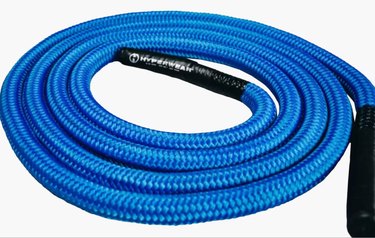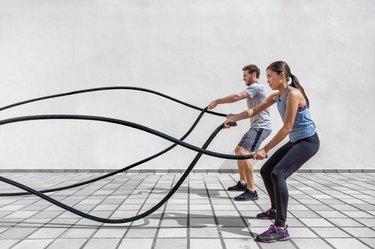


You may not think of battle ropes when you head to the gym with the goal of building fitness, strength and/or power, but this unusual piece of fitness equipment is a fun and effective tool for doing exactly that.
Read on to learn how to use battle ropes and how to incorporate them into your routine based on your goals — plus a 20-minute conditioning workout to help you get started.
Video of the Day
What Are Battle Ropes?
Battle ropes (also known as battling ropes) are ropes you can anchor to a sturdy fixture on the ground and move with your arms, though some ropes are designed so you don't need to use an anchor. They're available in a range of materials, including polyester, hemp manila and polypropylene.
Battle ropes also come in various lengths and thicknesses, but ideally, you want to use ones that are at least 50 feet long, says Noam Tamir, CPT, CSCS, a certified strength and conditioning specialist and founder of TS Fitness. You can shift the focus of any battle rope exercise by switching up one (or both!) of these variables.
Longer and thicker ropes that are more than two inches thick are ideal for short bursts of intensity to build power and muscle, Tamir says. They are great for more advanced exercisers. Meanwhile, ropes that are 1.5 inches thick are lighter and better suited for beginners or those who want to build cardiovascular endurance.
But if you're at the gym and see two ropes of equal thickness but one rope is longer than the other, choose the shorter one to make the exercise feel easier.
Why Use Battle Ropes?
Most cardio exercises, like running and cycling, involve using big lower-body muscles. Even cardio exercises that involve a lot of upper-body strength, like rowing, still rely heavily on the legs. But battle ropes are highly effective for building cardiovascular fitness while primarily working your upper-body muscles.
"[Battle ropes] are so much work, especially because most of us aren't used to getting our cardio by moving our arms really quickly, and that can really get your heart rate up," says Alison Heilig, CPT, CrossFit coach and author of The Durable Runner.
There's nothing wrong with using your legs for cardio, but if you have a lower-body injury, or your legs are still sore from a previous workout, it's helpful to have a cardio alternative that won't tax your lower body.
"When I broke my foot at the end of last summer, I did a lot of battle rope stuff because they didn't require me to use my foot," Heilig says.
And while battle ropes are primarily a cardio-focused exercise, you can also reap total-body strength and power benefits by using heavy rope. You can also tailor battle-rope exercises to hone in on certain body parts, like your shoulders, arms, back, core, chest, glutes and/or legs.
For example, you can do Russian twists or single-arm plank waves to focus on your core. To target your quads, do alternating reverse lunges while you do battle rope waves.
Plus, battle ropes are fun to use, which can help break up your usual routine.
"There are so many types of exercise equipment that we don't have to keep doing the same things over and over," Heilig says. "Any time we take the chance of trying something new, we're increasing our body's capacity to learn something new and to explore movement in a new way."
The Best Battle Ropes for Your Home Gym
- Rogue Hyper Rope Battle Rope (Roguefitness.com, $299.99)
- Profect Sports Pro Battle Ropes + Anchor Strap Kit (Amazon.com, $74.95)
- Perantlb Battle Rope With Cloth Sleeve (Amazon.com, $59.99)
How to Use Battle Ropes
It's important to stand with proper posture when using battle rope. In general, you want to stand with your knees slightly bent so you're in a quarter-squat. Stack your spine over your pelvis and brace your core to avoid overarching or rounding your back. You also want to keep your chest up, hips back and spine neutral, Tamir says.
"As your arms are moving, your core is going to be absorbing a lot of that movement, but if you're not putting yourself in a good position with your spine, your core won't be able to engage as well as you need it to distribute those forces," Heilig says.
One common mistake you want to avoid is pulling the ropes too tight because you won't be able to move them in a fluid pattern, and it makes the exercise harder than it needs to be.
"And then, it's going to require more muscular effort on your part because you're moving against the tension of the rope," Heilig says.
To achieve the ideal amount of tension, hold the battle ropes in your hands and walk back until you've pulled the ropes tight. Then, take two or three steps forward. In this position, you should be able to move the ropes fluidly.
Moreover, when doing alternating battle rope waves, you want to move the ropes with control and avoid slamming them into the ground, Tamir says. Moving the ropes with control allows you to further engage your core and upper body. You can make the exercise more challenging by adjusting the speed or height of the waves.
Tip
You can use battle ropes at the beginning of a workout with short, explosive bursts to help build power or at the end of a workout as a cardio finisher, Tamir says. Or, you can incorporate them into a circuit or HIIT workout by inserting them as a conditioning station in between other exercises.
20-Minute Battle Rope Workout for Beginners
This battle rope workout, demonstrated by Tamir, will burn your shoulders and get your heart pumping over time. Complete 4 rounds of this circuit, resting 30 seconds between each move. At the end of each round, rest for 2 minutes.
Move 1: Battle Rope Slam
- Start in a quarter-squat with your knees slightly bent and your feet slightly wider than shoulder-width apart.
- Grip one end of the battle rope in each hand with your elbows slightly bent.
- Brace your core and lift the ropes high. Then, slam them down into the floor as powerfully as possible.
- Repeat as soon as you return to the starting position.
Tip
To make the move more dynamic, jump as you lift the ropes. Slam them into the floor when you land.
Move 2: Battle Rope Overhead Press
- Stand tall with your feet hip-width apart.
- Grip one end of the battle rope in each hand in front of your shoulders. Your elbows should be bent with palms facing in.
- Brace your core and press the ropes up and down quickly, making sure to keep your elbows hugged in.
Move 3: Alternating Battle Rope Wave
- Start in a quarter-squat with your knees slightly bent and your feet slightly wider than shoulder-width apart.
- Grip one end of the battle rope in each hand with your palms facing in, elbows slightly bent.
- Brace your core to prepare, then raise and lower the ropes quickly, alternating between your left and right hand. Don’t slam the ropes into the ground; try to create a wave pattern that moves fluidly from your hand to the other end of the rope.
Move 4: Battle Rope Snake
- Start in a quarter-squat with your knees slightly bent and your feet slightly wider than shoulder-width apart.
- Grip one end of the battle rope in each hand with your palms together, elbows slightly bent.
- Brace your core, then whip the ropes out from side to side, creating a wave pattern.


